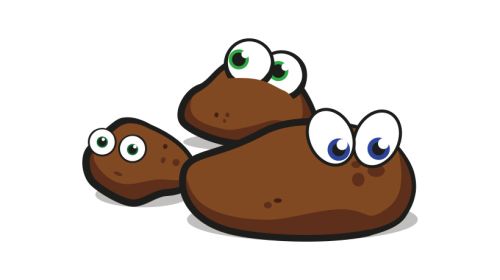Campylobacter are bacterial pathogens that cause intestinal infections. A Campylobacter infection (Campylobacteriosis, Campylobacter enteritis) manifests itself as severe diarrhea and abdominal pain. It is one of the food infections.
- When infected with Campylobacter, diarrhea occurs with up to 20 bowel movements per day.
- © iStock.com/PRImageFactory
The Campylobacter bacteria are now considered to be the most common pathogen causing intestinal diseases caused by food. Campylobacter have thus overtaken Salmonella. The number of infections increases especially in summer. Campylobacter infection is mainly caused by poultry meat and raw milk and must be reported to the health department. There are over 20 types of Campylobacter bacteria. Three of these types occur predominantly in humans: Campylobacter jejuni, Campylobacter coli and Campylobacter lari.
At a glance:
Causes of infection with Campylobacter
Campylobacter infections are mainly transmitted in humans through contaminated food. The main source of infection is raw or undercooked poultry meat and poultry products other than eggs. Unpasteurized milk (raw milk, raw milk cheese), contaminated drinking water, pets (especially puppies and cats with diarrhea) and raw minced meat are possible sources of infection for Campylobacter. Direct transmission from person to person is also possible. Children in particular are at risk of being transmitted from sick people, as just a few pathogens can trigger an infection in them. An infection can also occur when bathing in lakes if there are enough Campylobacter bacteria in the water.
Who is particularly at risk?
Campylobacter infection is particularly common among people between the ages of 20 and 29. Infants, children under six years of age, old people and people with impaired immune defense are also particularly at risk of contracting Campylobacter. Therefore, these groups of people should avoid foods such as cheese made from raw milk or undercooked meat to prevent infection.
Symptoms and course of Campylobacter enteritis
If Campylobacter has been infected, the typical symptoms usually appear two to five days later, sometimes one to ten days afterwards. The infection by Campylobacter usually begins with a strong feeling of illness including fever, headache and muscle pain, shortly afterwards severe, colicky abdominal pain and cramps as well as nausea and severe diarrhea occur. The diarrhea is severe (up to 20 visits to the toilet per day), very watery and sometimes greenish. Bloody stools can also occur in up to 30 percent of cases. As a rule, the gastrointestinal complaints persist for a week, but in rare cases longer.
In addition to the typical course of a Campylobacter infection, it can also be completely untypical. Sometimes an infection goes unnoticed, but the infected person can still infect other people with Campylobacter.
How long are Campylobacter bacteria contagious?
As long as the Campylobacter bacteria are in the stool, the person is also contagious. This time is on average two to four weeks – The sick person is usually still infectious even after the symptoms have subsided. Immunocompromised people, such as HIV patients, are contagious for much longer because Campylobacter can remain in their stool for months. In order to avoid infecting other people, thorough hand hygiene – especially after using the toilet – must be observed.
When should you see a doctor?
Normally the symptoms of Camyplobacter enteritis subside after about seven to ten days at the latest, even without treatment, as with other diarrheal diseases. It is important to drink enough fluids in the form of water, tea, and broth to make up for the loss of fluids caused by diarrhea.
You should definitely consult a doctor if the fluid loss cannot be compensated for and the symptoms such as fever, diarrhea and abdominal cramps are too severe overall. The doctor can then give you antipyretic drugs, pain relievers and, if necessary, remedies such as electrolytes Dehydration prescribe. In rare cases, an antibiotic can be used. The drug of choice is erythromycin. Medicines for diarrhea that are over the counter in pharmacies should not be taken without consulting a doctor.
Diagnosis of Campylobacter
The doctor asks the sick person about the current symptoms. The person concerned may be able to remember a triggering event, for example a certain food that they ate. A Stool sample which is examined in the laboratory for Campylobacter bacteria in order to be able to make the diagnosis with certainty. The doctor is legally obliged to report an infection with Campylobacter to the health department no later than 24 hours after the diagnosis. If the infected person works with food, the doctor must already report the suspicion of the infectious diarrhea with Campylobacter.
Measures for severe diarrhea caused by Campylobacter
Drink enough (at least 3 liters / day – water, tea and vegetable stock) to prevent dehydration!
Always add a pinch of salt to the water to compensate for the loss of salt.
Take it easy and stay in bed.
Wash your hands thoroughly after using the toilet.
Do not prepare food for others.
Diet for Campylobacter Enteritis
If you have an infection with Campylobacter, you may not want to or be unable to eat for the first few days due to the symptoms. Therefore, you should then start carefully with a gentle, low-fat diet. This can be, for example, grated apples, rusks, pretzel sticks, crispbread, the classic gruel, carrot soup or natural yogurt.
Preventing Contagion
Good hygiene prevents (further) infection with Campylobacter. Campylobacter are sensitive bacteria, but they survive low temperatures and can therefore still be found on meat, in thawing water and on kitchen appliances even after meat and poultry products have been thawed. Infected people are also contagious and if they are poorly hygienic, they can spread Campylobacter by smear infection via hands, door handles and the like. Therefore, careful hygiene is essential.
1. Kitchen hygiene
After preparing meat – especially poultry – wash all kitchen utensils used, such as boards, knives, work surfaces, etc., hot and thoroughly immediately and do not let anything else come into contact with them. Of course, wash your hands thoroughly after touching raw meat.
Always cook minced meat and poultry through!
Wash towels and dishcloths regularly at 60 ° C. Change dish brushes and sponges regularly or wash them with hot water.
Raw meat and poultry should never be washed under the tap, as the splashes of water can spread the germs even further.
2. Hand Hygiene & Others
- Proper hand washing after every use of the toilet (or after changing diapers for a sick child), before eating and after every contact with raw meat. Thoroughly dry hands with a clean cloth. Breastfeeding women should wash their hands thoroughly before breastfeeding.
- Sick people should have their own towel and washcloth in the bathroom, which are also washed regularly at 60 ° C.
If your child is affected, you must inform the facility (day care center, kindergarten or school) that there is an infection with Campylobacter and you must leave the child at home. People who work with food are not allowed to go to work with the reportable disease in order to prevent the further spread of Campylobacter.
Long-term effects of a Campylobacter infection
Complications and long-term effects are rare after a Campylobacter infection. Nevertheless, long-term effects in the form of arthritis, meningitis, facial paralysis (facial paralysis) or, in very rare cases, Guillain-Barré syndrome can occur. The cause of the long-term effects of Campylobacter are specific antibodies that are formed during infection and can also be directed against the nerve cells in the body.


